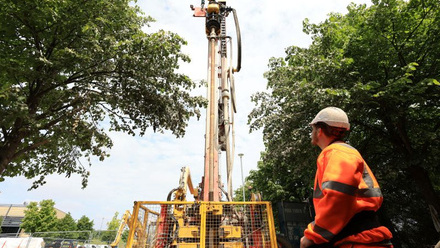Transforming the energy system to hit net-zero
Attaining net-zero greenhouse gas emissions by 2050 will require nothing short of the complete transformation of the energy system. Dr Richard Oblath FIMMM, Chair of the IOM3 Energy Transition Group, brings us up to speed on the progress.

It has been eight years since COP21 in Paris when targeting a global temperature rise of less than 2⁰C, versus a baseline of the pre-industrial level, was agreed to by the nations of the world. This was made more specific in 2021 to no more than 1.5⁰C at COP26 in Glasgow, UK.
Nations representing the most current greenhouse gas (GHG) emissions have, in turn, pledged or legislated to reach net-zero by 2050 – notable exceptions are China and India targeting 2060 and 2070, respectively. However, the actions to meet these aspirations are falling behind the necessary speed of implementation.
Indeed, the Russian invasion of Ukraine has re-emphasised the three dimensions of the energy transition trilemma – security, affordability and sustainability.
As we approach COP28 later this year in the UAE, the UN’s Intergovernmental Panel on Climate Change (IPCC) has published the Sixth Assessment Report: 2023. This concludes that limiting the global temperature rise to 1.5⁰C is still possible, but only if all countries act immediately. As the IPCC makes clear, the world needs to reach peak GHG emissions before 2025 at the very latest, nearly halve emissions by 2030 and reach net-zero emissions around mid-century, while also ensuring a just and equitable transition.
Clearly, the current pathway of emissions not having peaked yet, indicates that the world will overshoot this target and thus exceed the peak 1.5⁰C temperature rise.
From zero to hero
Including its production, distribution, storage and consumption, the energy sector accounts for about 75% of current sources of GHGs. If we are to get to net-zero by 2050, available sources of energy with much lower emissions, such as renewables and nuclear fission, need to be brought online as quickly as possible.
Did you know?
Today, the energy sector accounts for around 40% of total methane emissions attributable to human activity, second only to agriculture. In 2022, the global energy industry released nearly 135Mt of methane into the atmosphere, only slightly below the record highs seen in 2019.
Source: International Energy Agency, Global Methane Tracker 2023
Technical processes and materials improvements in the next few decades will also allow additional, commercial, low-GHG, energy production operations – such as small modular reactors (SMRs) and perhaps nuclear fusion – to be added to the mix.
However, transitioning the current energy sector will not be enough as the world’s population is still growing (peaking at 10 billion by mid-century), alongside increasing living standard aspirations – and thus energy per capita – of those living in the developing world.
One of the lowest cost paths to the energy transition is in fact significantly increasing energy efficiency, especially in the OECD countries of the world. In addition, further decreases in the number of people living in poverty should be part of the just transition. As reported in the International Energy Agency (IEA) World Energy Outlook 2023, there are still over one billion people living without access to electricity, plus hundreds of millions with only intermittent supply, and nearly three billion who cook using solid fuels that pollute the air where they live.
The simplistic solutions of rapidly reducing GHG emissions by stopping additional investments in fossil fuels will therefore harm billions in the developing world, plus significantly inflate costs in the developed world. Through mid-century and beyond, the world will still need fossil fuels – peaking the use of coal now, then oil, and then gas for energy production (in addition to non-energy uses of hydrocarbons).
We are however in the early stages of an inevitable and responsible phase-down of all fossil fuels for energy. Although, these materials will still be needed for non-energy applications such as synthetic chemicals and pharmaceuticals.
The fossil fuel energy sector (production, distribution, and consumption) also needs to reduce its associated GHG emissions via minimising leaks (mostly of methane) to 'as low as reasonably practicable', plus via the implementation of carbon capture and sequestration (CCS).
Much of the likely largest increases in renewable energy for the power sector will come from sources that are intermittent, thus grid reliability from the multitude of power generation provenances will become more and more important. Energy storage via multiple technologies such as hydrogen and batteries will also be required. The closer the world gets to a net-zero grid, the more important reliable, always-on technologies become in supporting that grid and critical operations within it.
Global progress
So, attaining net-zero GHG emissions in the energy sector by 2050 will require nothing short of the complete transformation of the global energy system.
Despite spending being below that needed to get on track, clean energy investment did reach a record high in 2022 (see box-out below).
Did you know?
For every US$1 spent on fossil fuels, US$1.7 is now spent on clean energy worldwide, up from 1:1 in 2017.
Source: International Energy Agency, World Energy Investment 2023.
Public research, development and demonstration (RD&D) expenditure also plays a significant role in fostering novel clean-energy technologies and bringing them to market. The IEA reports that global public spending on energy R&D rose by 10% in 2022 to nearly US$44bln, with 80% devoted to clean-energy topics.
Therein, low-carbon energy progress is on track for 2050 with the implementation of low-energy lighting, solar photovoltaic (PV) installations and a growing market share of electric vehicles – now at 15% of new car sales. However, in the multitude of other sub-sectors, accelerated policy support and investment are needed to quickly expand momentum across more countries and to all parts of the energy system to move the world closer to its goals.
According to the International Renewable Energy Agency, global renewable capacity additions grew by 13% in 2022 to nearly 340GW, mainly from PVs. Hydropower grew, owing to several large projects in Asia, but annual wind capacity additions fell 21% from 2021 to 2022, declining for the second year in a row. Geothermal energy market growth remained small but stable.
Clean energy supply chains expanded substantially in 2022. The announced pipeline of new manufacturing facilities is also growing. If all were to come to fruition, solar PV and battery manufacturing capacity could meet deployment levels needed in 2030. Conversely, existing capacity plus announced projects for wind, electrolysers and heat pumps remain insufficient.
Moreover, all clean energy supply chains remain highly geographically concentrated, with China alone accounting for 40-80% market share across these five technologies.
Meanwhile, CCS is set to expand rapidly if all planned projects come online, a six-fold increase from current levels.
However, estimated growth in China masks sluggishness elsewhere, maintaining China’s status as the largest public spender on energy R&D. OECD countries saw their total government spending on energy RD&D stagnate in 2022, although new policies – notably the US Inflation Reduction Act – promise increases in the coming years.
This is critical as half the emissions reductions needed to reach net-zero come from technologies not yet on the market. There are demonstration projects for technologies that are at Technology Readiness Level of 7+ that could be commercially ready by 2030 and contribute to achieving net-zero emissions by 2050.
Furthermore, clean energy currently employs over 50% of total energy workers, owing to the substantial growth of new projects coming online – a trend seen across most global regions.
Yet against this backdrop, for the first time in decades, the IEA reports that the number of people without access to electricity is set to increase in 2022. The rise is mostly in sub-Saharan Africa, where the number of people without access is nearly back to its 2013 peak, erasing years of improvements.
Low-carbon energy investment in emerging markets and developing countries needs to grow steeply to reach climate goals, with less than 2% of the global total being enough to secure universal access to electricity and clean cooking fuels.
Overall, Nationally Determined Contributions (NDCs) and new net-zero emission pledges in the past two years would bring significant emissions reductions and curb the temperature rise compared to the pre-Paris baseline. But neither would be enough to keep the temperature rise to 'well below 2°C' nor reflect efforts to limit the temperature increase to 1.5°C above pre-industrial levels. Additional action is required in a wide variety of areas, especially focused on accelerating the implementation of current technologies in the remaining 2020s. GHGs are cumulative, thus the earlier reductions are achieved the more effective they will be.
UK progress
Legislation and actions taken by successive UK Governments have reduced GHG emissions from the power sector by two-thirds since 1990, thus putting the country at the vanguard of energy decarbonisation. A large part of this success was the early coal phase-out, replacing it with North Sea gas.
Post COP21, the UK was the first nation to pass legislation in 2019 to reach net-zero by 2050. Then at COP26, the UK increased its NDC to target GHG reductions of 68% by 2030 and 78% by 2035 (including a net-zero power system) versus a 1990 baseline. These aspirations though laudable have not been fully supported by legislated action.
Recent independent assessments, including those from the UK Climate Change Committee, have noted much reduced confidence in the UK meeting its goals from 2030 onwards, mainly due to a lack of additional public funding and policies to aid the private investment push for a faster pace of progress.
Areas that need specific and urgent attention include:
- Strengthening and expanding the national electricity grid (and transnational interconnectors) to facilitate the needed large increase in industrial and personal (residential and transportation) electrification. Some of the problems are not technical but relate to matters such as planning permission delays, which have suddenly increased to circa 14 years for large new grid connections (including the multi-layers of jurisdictions – UK Government, devolved governments and local government), and supply chain shortages especially in high voltage DC cabling.
- The Contracts for Difference scheme in the UK has been successful in boosting renewable electricity supply, resulting in 48% of all electricity from low-carbon sources in Q1 2023. However, the recent increase in borrowing costs and inflation have combined to diminish the programme’s future effectiveness. New funding was recently announced and additional help will be needed to keep the UK on track for its commitment to a decarbonised power sector by 2035.
- The UK Government’s incentives have been successful to date, especially in promoting investments in offshore wind power but these need to be broadened to boost other low-carbon energy sources with less intermittency, such as hydro, tidal and geothermal. As the use of North Sea gas has reduced slowly over time, 24/7 power such as from nuclear fission will become more important. It is critical that the ambition for 24GW of new large nuclear plants on-stream ahead of 2050 is kept on schedule, as well as the commercialisation of SMRs in the 2030s. Nuclear fusion holds immense promise but reaching commercialisation is not likely at large scale in time to impact net-zero, although continuing funding on its development is still critical in the long run.
- Energy storage, for the times when intermittent sources are not producing, is a component of the emerging low-carbon, hydrogen economic sector. Low-carbon hydrogen at scale is dependent both on economic production using renewable electricity via the electrolysis of water, but also commercialised CCS facilities linked to steam-methane-reforming hydrogen production. Low-carbon hydrogen’s most important applications may be in the more difficult-to-decarbonise steel, aluminium and cement industries. In the energy domain, low-carbon hydrogen may find applications in heavy duty road vehicles using fuel cells and in producing low-carbon ammonia for marine fuels. Early developments in the hydrogen value chain have been slow in being brought on-stream but are poised to become more important in the 2030s.
A recent controversy has been the government’s decision to grant new oil and gas licenses in the North Sea. The reality is that 76% of total UK energy demand was met by oil and gas in 2022. Since most of the demand for oil and gas is for essentials such as heating, cooking, transport and electricity generation, it will be required until alternatives are available. In 2022, UK net imports of oil and gas were 37%, with almost half being liquefied natural gas (LNG) mostly from Qatar and the US.
From a net-zero standpoint, increasing new domestic production is a positive step. The most recent UK platforms have 20% of the emissions intensity of older installations, and LNG imports have at least twice the GHG emissions versus domestic production. Maximising UK production also increases energy security and positively impacts the UK economy.
In parallel, there are significant efforts co-ordinated by the regulator, the North Sea Transition Authority (formerly the Oil & Gas Authority), with technical support from the producers and the Net Zero Technology Centre (formerly the UK Oil & Gas Technology Centre), on transitioning the North Sea to net-zero. The focus is on continuing the reduction in gas (methane) flaring, decarbonising the energy needed to produce hydrocarbons via the use of wind and tidal power, and the eventual alternative use of decommissioned assets for items such as CCS and hydrogen storage.
Members of IOM3, representing each technical community, are very well placed to greatly enhance and implement the various technologies, and production and supply chain requirements, as well as promote the circular economy to meet the critical challenges in reaching net-zero by mid-century.
Many experiences of older members who were originally trained for the coal then oil and gas industry can be directly applied to the mining of key materials and minerals for electrification, including potentially deep-sea mining, plus the use of old wells and mines for CCS. The materials and minerals challenges, of for instance, ever-larger wind turbines to be used in offshore environments, more efficient electrolysers, SMRs and nuclear fusion, will also involve many members.
One of the 22 IOM3 Technical Communities is the Energy Transition Group (ETG), formed in 2019 out of the former Oil & Gas Division. The ETG has become one of the larger primary or secondary TCs selected by IOM3 members. In mid-2022, new members of the leadership team were added to replace members and to diversify its ranks across various technologies and industries directly related to the energy transition, while increasing the gender, ethnic background and age diversity. The refreshed leadership team is developing an energy transition policy for IOM3, which should be made public in Q4 2023.







